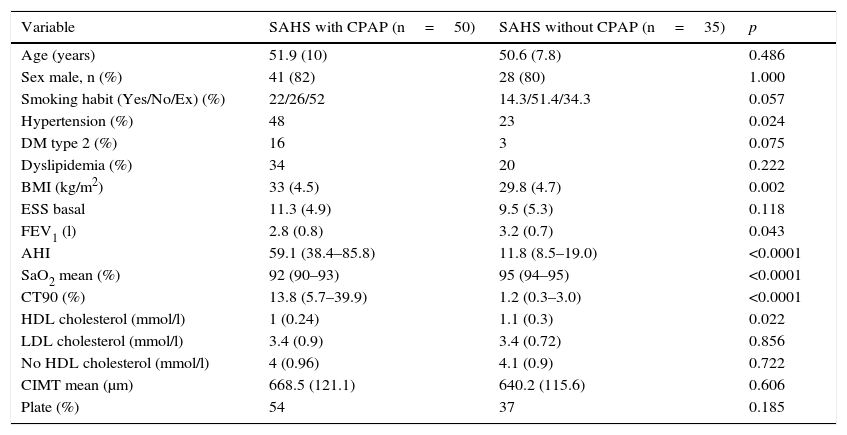Obstructive sleep apnoea (OSA) is associated with an increased risk of cardiovascular disease. Our objective was to evaluate subclinical atherosclerosis in OSA patients and the effect of continuous positive airway pressure (CPAP) treatment on carotid intima-media thickness (cIMT).
Patients and methodWe included 125 patients with suspected OSA. After polysomnography, 107 patients were diagnosed with OSA; 58 of these met the criteria for CPAP treatment. cIMT was measured by ultrasonography at baseline in all patients and after 2 years of follow up in 50 patients on CPAP and 35 without CPAP treatment.
ResultsThe average cIMT was significantly thicker in OSA than in non-OSA patients (665±120 vs. 581±78μm, p=.005) and did not differ according to OSA severity. Atheromatous carotid plaque was more prevalent in OSA than non-OSA patients (48 vs. 2%, p=.004). Among OSA patients, the mean cIMT remained stable over time in the group without CPAP, whereas cIMT decreased markedly in the CPAP group (679±122 vs. 631±117μm, p<.0001).
ConclusionsIncreased cIMT was associated with presence of OSA, but not with its severity. Carotid ultrasound in OSA is a reliable marker of atherosclerosis. CPAP treatment with CPAP in OSA reduces cIMT and cardiovascular risk.
El síndrome de apnea-hipopnea durante el sueño (SAHS) es un factor de riesgo de arteriosclerosis. Nuestro objetivo fue evaluar la arteriosclerosis subclínica en los pacientes con SAHS y el efecto del tratamiento con continuous positive airway pressure (CPAP, «presión positiva continua de la vía aérea superior») sobre el grosor íntima-media carotídeo (GIMc).
Pacientes y métodoSe incluyeron 125 pacientes con sospecha de SAHS. Después de la polisomnografía, 107 pacientes fueron diagnosticados de SAHS; 58 cumplían criterios de tratamiento con CPAP. El GIMc se midió mediante ecografía a nivel basal y a los 2 años de seguimiento en 50 pacientes con SAHS en tratamiento con CPAP y 35 SAHS sin criterio de CPAP.
ResultadosLos valores del GIMc fueron superiores en los pacientes con SAHS respecto a los que no tenían SAHS (665±120 frente a 581±78μm, p=0,005), sin asociarse con su nivel de gravedad. La presencia de placas de ateroma fue más prevalente en los SAHS que en los no SAHS (48 frente a 2%, p=0,004). En los pacientes con SAHS, la media del GIMc permaneció estable durante el seguimiento en el grupo sin CPAP, y en el grupo tratado con CPAP disminuyó significativamente (679±122 frente a 631±117μm, p<0,0001).
ConclusionesLos pacientes con SAHS presentan un mayor grado de arteriosclerosis subclínica y no se asocia con su gravedad. La ecografía carotídea en el SAHS es un marcador fiable de arteriosclerosis. El tratamiento con CPAP en el SAHS disminuye el GIMc y el riesgo cardiovascular.
Artículo
Comprando el artículo el PDF del mismo podrá ser descargado
Precio 19,34 €
Comprar ahora












